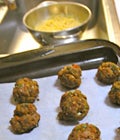- Home •
- Books by Category •
- Imprints •
- News •
- Videos •
- Media Center •
- Reading Group Center
A taste of Italian America, with Lidia Bastianich's Spaghetti and Meatballs
Lidia Bastianich is widely considered the queen of Italian cooking, and with good reason: her recipes have taken us from the most authentic dishes of the Italian countryside to the most beloved dishes of her family kitchen. In her latest book, Lidia’s Italy in America, Lidia and her daughter Tanya Bastianich Manuali take us on their most exciting journey yet: a road trip across America, into the heart of Italian American cooking today. As Lidia shows us, every kitchen and community has produced something different, with little clues hidden in each dish: the Sicilian-style semolina bread of the New Orleans Muffuletta sandwich, the crunchy Neapolitan crust of New York pizza, and the multitudes of breadcrumb-stuffed vegetables that came to our shores long before fresh peppers or tomatoes ever did. “Food, after all, is the blueprint of who we are,” says Lidia. “The food of our culture gives us strength and identity as a group and as individuals…Today, this country’s Italians are truly as American as apple pie, but they have also held on to the traditions of their heritage.”
Italian American food has its own distinct culinary traditions, and its own special flavors. So to feature those flavors, what better dish to make than spaghetti and meatballs, complete with a side of crispy garlic bread? Sit down to a table with these dishes and you end up devouring not only a fantastic meal, but also a history of American cuisine that evolved out of necessity, ingenuity, and a love for delicious food.
Start your meal by getting your garlic bread ready to go–in Italy, this dish was called bruschetta or fett’unta, an appetizer that took leftover bread and put it to good use with a coating of olive oil and fresh garlic. In America, this became garlic bread, and rarely do you find an Italian restaurant that leaves it off the menu. For Lidia’s version, peel a few cloves of garlic and let them soak in a small bowl of olive oil for 30 minutes (to let the garlic flavor soak into the oil).
Time to start your meatballs! (Lidia’s recipe makes a lot of meatballs, making three extra quarts, so you can either scale the recipe down by half, or just make a big batch and freeze the rest.) Preheat the oven to 425 degrees. Get out your food processor and pulse together some carrot, celery, and onion until they make a fine-textured paste, or pestata. (This will help keep the meatballs light and juicy.)
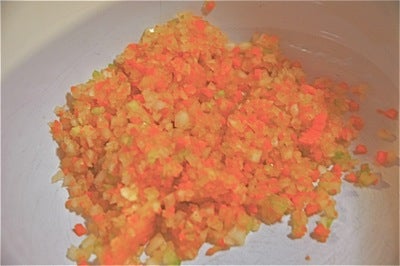
Scrape your pestata into a large bowl and combine with beaten eggs, dried oregano, chopped parsley, salt, 2 cups bread crumbs, and three kinds of meat: beef, pork, and veal. (Though Lidia says you can make it with one or two types of meat, combining all three will up the complexity of the flavor by a lot–and remember you’ll have plenty of leftovers!)
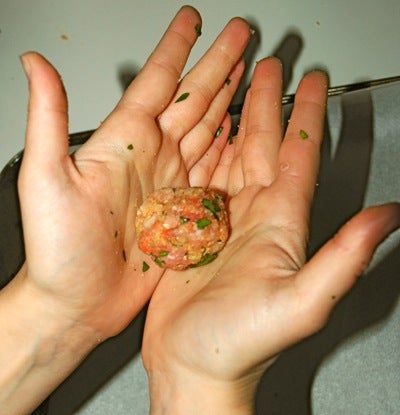
Roll the mixture between your hands into golf-ball-sized rounds and place on a parchment-lined baking sheet. (The full recipe will make about 48 meatballs). Slip the pan into the oven until the meatballs are browned all over, about 18-20 minutes. They won’t be completely cooked through, but don’t worry, they’ll finish cooking in the sauce.
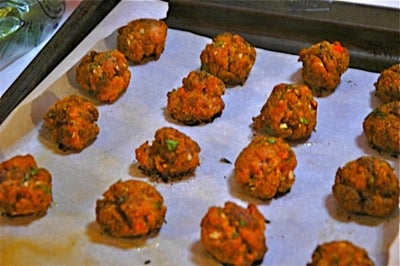
Bring a pot of salted water to boil for your pasta. Slip in your spaghetti and cook until al dente, then drain, saving about a half cup of pasta water (you’ll use this to help thicken your sauce as it cooks–never rinse your pasta, or else you wash all that rich flavor away!)

Start your sauce: heat some olive oil in a large pot or pan, then toss in a sliced onion, sautéing until it turns transparent. Ladle in your remaining pasta water, and simmer the onion until it breaks down, 2-3 minutes. Scrape a clear spot in the center of the pan and sprinkle in some salt, three bay leaves, and some peperoncino flakes (crushed red pepper). Let your peperoncino toast in the center of the pan for a minute–this will intensify the spiciness of the herb, the olive oil, and eventually your sauce.
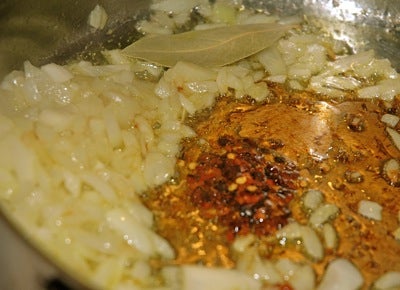
Pour in a few cans of plum tomatoes (preferably San Marzano, and crushed by hand–it’s fun, trust me) and stir the sauce together. Slosh out the tomato cans with hot water and add it to the pot, add a little more salt, and let the sauce simmer for about 10-20 minutes.
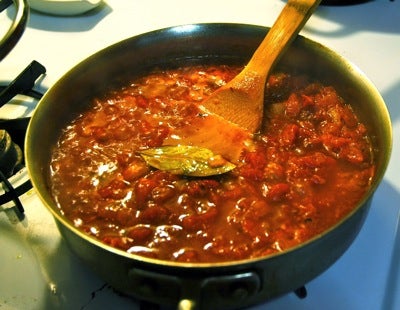
When the meatballs are done cooking, slip them into the sauce and bring it back to a simmer, shaking the pan gently to cook and coat the meatballs. After 30 minutes, the sauce will be thick and flavorful, and your meatballs warm and juicy. (Resist eating it straight out of the pan.)
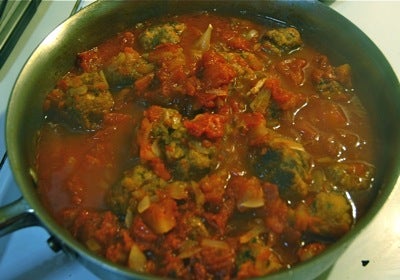
Almost ready to eat, and now time to make the garlic bread: Turn your oven down to 400 degrees, and get your garlic bread ready: brush a loaf of Italian bread, cut lengthwise and in half into four pieces, with the flavored oil, rubbing with the garlic cloves and scattering them over the top, along with some dried oregano.
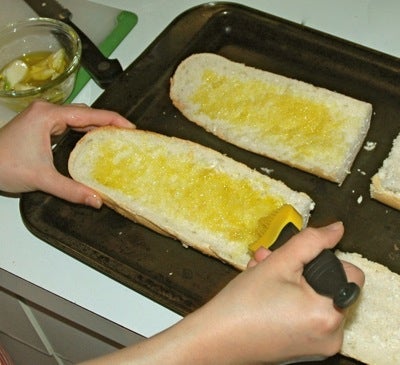
Slip the bread into the oven and bake until just golden and crispy, about 4-5 minutes. Remove the large garlic pieces (or leave on if you love garlic), and sprinkle the bread with salt.
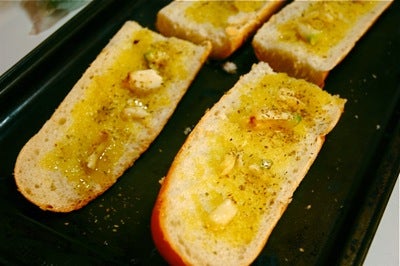
All you have to do is finish up the pasta–plop the spaghetti back into its original cooking pot, add half the sauce (no meatballs yet), and toss. Portion the pasta out into warm bowls and top each serving with a few meatballs and additional sauce.
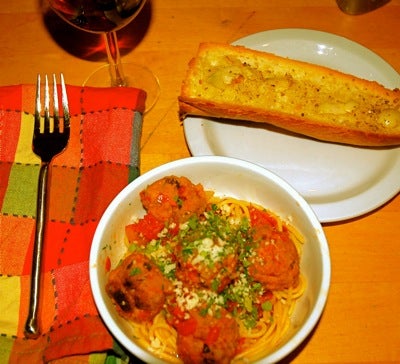
Serve immediately, using your garlic bread to mop up any sauce left at the bottom of your bowl. It may seem uncouth, but hey, generations of Italian Americans have honed these recipes, and there’s no denying that tradition equals tastiness. Bravo to Lidia, for her journeys around Italian America, and for bringing these delicious souvenirs back for our enjoyment!
Want to take on Lidia with your favorite Italian-American dish? Enter our contest on Facebook–submit your favorite Italian American recipe from your personal collection with a brief story explaining why the dish is special to you. Make sure to share a photo of the dish (or your family and friends enjoying it!) to help tell your story. The winner will receive a complete collection of Lidia books, some special ingredients and kitchenware, and best of all, a conversation with Lidia herself! Enter now!
